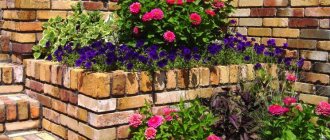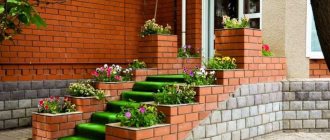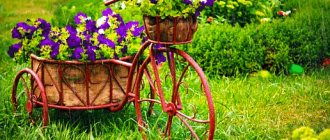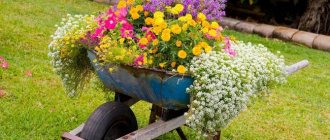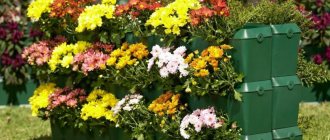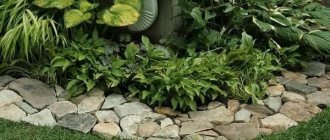If you live in a private house or have a dacha outside the city, then the issue of landscaping the local area is especially relevant for you. Since ancient times, flowers have been considered the best decoration. Anyone can arrange a flower bed or decorate a flower garden. It's not as difficult as it seems at first glance.
What is the difference between these elements of landscape design? For a flower garden, the shape is not important; it can be very diverse. But the flowerbed requires strict adherence to geometry; it can have the shape of a circle, rectangle, or square. And unlike a flower garden, it is always located in the open ground.
In this article we will look at how to make a beautiful flower bed on your site with your own hands.
Rules you need to know
The flowerbed must be organically integrated into the surrounding landscape, otherwise it will look ridiculous. It is optimal to combine annual and perennial plants, as well as plants with different beginnings and flowering periods.
Plants must be combined in height. First, ground cover should be planted, then low-growing, medium-growing and tall.
The shape of the flower bed depends on the architecture of the landscape. It can be trapezoidal, square, pyramidal, triangular, rectangular.
When choosing flowers for a flower bed, you need to take into account your own wishes and preferences.
Do not forget about the competent selection of the color palette of the composition. Warm tones visually bring you closer, while cold tones move you away. Harmoniously selected tones and shades add aesthetics to the flowerbed.
Selection of plants for flower arrangements
When laying out a flower bed, it is important to choose the right perennial plants and be able to combine them correctly
To reduce the time spent on updating groups of plants in a flower garden, predominantly long-flowering plants, i.e., perennials, are selected. These include shrubs, trees and some herbaceous plants.
In the center of the flower garden, where access is usually limited, tall perennials are planted, the care of which should not be frequent.
Please note: conifers, evergreen viburnum and barberry play an excellent role as a compositional center, which require rare pruning and at the same time retain their green pores all year round.
In the middle part of the flower bed, those plants are planted that are replaced every 2-3 years or less often, and low-growing perennials or annuals are placed along the perimeter of the flower beds. Any plant species used should have a relatively long flowering time.
Selection of perennial plants for flower garden design
As a rule, when selecting plants for flower arrangements, special attention is paid to those that have interesting leaf colors and colorful original fruits: they will also play their role in giving the flowerbed color and originality. This type of flower includes, for example, physalis, and among the shrubs, beautiful fruit and snowberry stand out.
For the convenience of selecting perennial plants when planning a flower bed, the following table will be given:
| Name | Color spectrum | Height | Flowering period |
| spirea | white | medium-sized shrub | summer |
| hydrangea | purple-pink shades | medium and tall shrub | summer |
| viburnum | white | tall bush | spring Summer |
| barberry | white | low and medium-sized shrub | late spring |
| chaenomelis | deep pink | medium and tall shrub | early spring |
| forsythia | yellow | medium and tall shrub | early spring |
| juniper | shades of green | creeping perennial | all year round |
| honeysuckle | White yellow | liana or tall shrub | summer |
| mock orange | white | tall bush | summer |
Types of flower beds
Flowerbeds are divided into:
Carpets. They have a square or rectangular shape and are usually planted with low flowers. This is a popular decoration for parks and gardens.
Irregular. Some flowers replace others, that is, plants bloom at different times.
Regular. All plants have the same onset and duration of flowering.
Monofloral flower beds. The simplest option. Flowers of the same type and variety are planted. The rosary belongs to this type.
Traditional. They are an ordinary bed dotted with plants, and when some finish blooming, others begin to bloom. In other words, continuous flowering is the main feature of this type of flower bed.
Chameleon. This flowerbed is similar to the traditional one, but there is one difference - a play of contrasts. Flowers have different colors and the change of tones occurs abruptly.
Vertical. Used for decorating gazebos, arches, fences, retaining walls, etc.
Ring. Designed to frame individual elements of garden design, be it a fountain, a sculptural group, a bush or a tree.
Floating. Used to decorate an artificial pond.
Hanging. They are based on wicker baskets. This is the perfect decor for a gazebo or patio.
Separately, it should be noted:
Alpine slides. These are flower beds located on hills and planted with low perennials. Additionally, it is possible to use stones of different sizes as a base for planting flowers.
Border. This type of flower bed is used to frame paths and platforms.
Flowerpot. This is a special type of flower bed, with which you can plant trees in those places where it is not possible to plant a flower arrangement of another type.
Multidimensional flower beds. To create them, landscape stylists use additional objects.
Diagram of a flower garden at the dacha
In fact, a flower garden is a broader concept and, according to the prevailing opinion of experts, includes both flower beds and flowers planted in flowerpots (containers), incl. installed on all kinds of vertical structures, etc. In general, the flower garden design can be anything.
Read also: Is it possible to prune trees?
A flowerbed is a piece of land, in most cases geometric in shape and with a closed contour (circle, oval, square, rhombus, rectangle), on which it is customary to plant annual plants or combine annuals with perennials. We offer you several simple, and at the same time beautiful schemes for arranging a flower bed in a summer cottage or garden plot:
How to properly plant a flowerbed yourself
Prepare the site. Its level should be higher than the sidewalk level. Achieve elevation by making a mound of the desired size.
Give the site the required shape. A cord will help you make a circle, and a regular tape measure will help you make a square or rectangle.
If desired, you can build a fence from bricks or irregularly shaped stones.
Plant the plants selected in advance. First, plant those of them that are assigned the role of central figures (no more than 3 - 5 pieces). These can be perennials, evergreens, bushes and even small trees. Then plant the rest around them. Remember, low plants are usually planted along the edges of the flower bed.
Recommendations
Landscape decorators give the following recommendations for creating a flowerbed with your own hands:
- You should not choose flowers for your flower bed thoughtlessly. They must be combined with each other.
- The most popular are flower beds with regular geometric shapes, since they are easier to fit into the existing landscape.
- When designing this type of flower garden, you need to take into account the configuration of architectural structures in the local area.
- The flowerbed should only be placed in an area where there is a suitable background for it.
- To create a flower bed, it is best to opt for low-maintenance flowers.
- Before you get down to business, you need to think through a clear procedure. This will help avoid mistakes.
Popular design for flower beds
The photo of do-it-yourself flower beds clearly shows that they can be made from:
Old things. This could be an old tank, bathtub, sink, toilet, shoes. You just need to paint them in rich, cheerful shades.
Car tires. It’s easy to make an unusual, beautiful flower bed out of them - you just need to cut off the side of the tire. You need to fill the resulting container with soil and plant plants in it.
Antique-style wheelbarrows and carts. Such flower beds add a rural ambiance to the setting.
Bicycle. This composition looks very interesting.
Out-of-fashion furniture. By combining flowers and individual pieces of furniture, you can create a real masterpiece of landscape craftsmanship. Such compositions look very original and stylish.
Use your imagination, don’t be afraid to experiment, and you can create not just a flowerbed, but a work of art that will become the source of your pride and the envy of your neighbors.
Rockery flower garden
Recently, rock gardens - a type of flower bed in which natural stones are actively used in the design. This is a complex structure, which, however, is quite possible for anyone to build - if only there was a desire, because “complicated” does not always mean “difficult”. Rockeries usually imitate rocks and mountain ranges, and therefore belong to multi-level flower beds, which is clearly visible in the photo. “Popularly” they are also known as “alpine slides”, which is not entirely true: rock gardens are distinguished by strict requirements for planted plants - they must only be representatives of the flora of alpine meadows and foothills, which is practically impossible to implement at home.
